inflation pressure TOYOTA YARIS HYBRID 2013 Owners Manual
[x] Cancel search | Manufacturer: TOYOTA, Model Year: 2013, Model line: YARIS HYBRID, Model: TOYOTA YARIS HYBRID 2013Pages: 700, PDF Size: 28.68 MB
Page 5 of 700
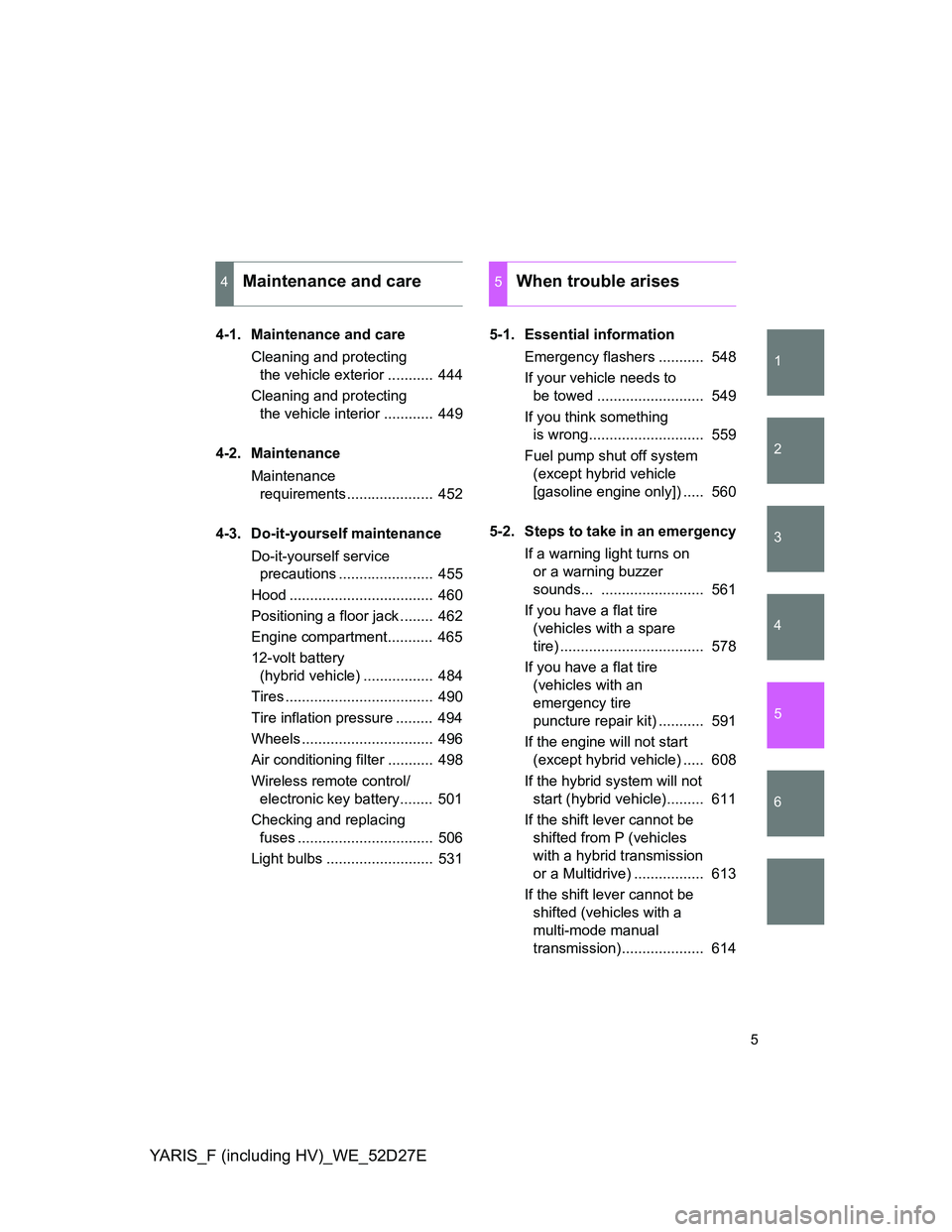
1
2
3
4
5
6
YARIS_F (including HV)_WE_52D27E
5
4-1. Maintenance and care
Cleaning and protecting
the vehicle exterior ........... 444
Cleaning and protecting
the vehicle interior ............ 449
4-2. Maintenance
Maintenance
requirements..................... 452
4-3. Do-it-yourself maintenance
Do-it-yourself service
precautions ....................... 455
Hood ................................... 460
Positioning a floor jack ........ 462
Engine compartment........... 465
12-volt battery
(hybrid vehicle) ................. 484
Tires .................................... 490
Tire inflation pressure ......... 494
Wheels ................................ 496
Air conditioning filter ........... 498
Wireless remote control/
electronic key battery........ 501
Checking and replacing
fuses ................................. 506
Light bulbs .......................... 5315-1. Essential information
Emergency flashers ........... 548
If your vehicle needs to
be towed .......................... 549
If you think something
is wrong............................ 559
Fuel pump shut off system
(except hybrid vehicle
[gasoline engine only]) ..... 560
5-2. Steps to take in an emergency
If a warning light turns on
or a warning buzzer
sounds... ......................... 561
If you have a flat tire
(vehicles with a spare
tire) ................................... 578
If you have a flat tire
(vehicles with an
emergency tire
puncture repair kit) ........... 591
If the engine will not start
(except hybrid vehicle) ..... 608
If the hybrid system will not
start (hybrid vehicle)......... 611
If the shift lever cannot be
shifted from P (vehicles
with a hybrid transmission
or a Multidrive) ................. 613
If the shift lever cannot be
shifted (vehicles with a
multi-mode manual
transmission).................... 614
4Maintenance and care5When trouble arises
Page 9 of 700
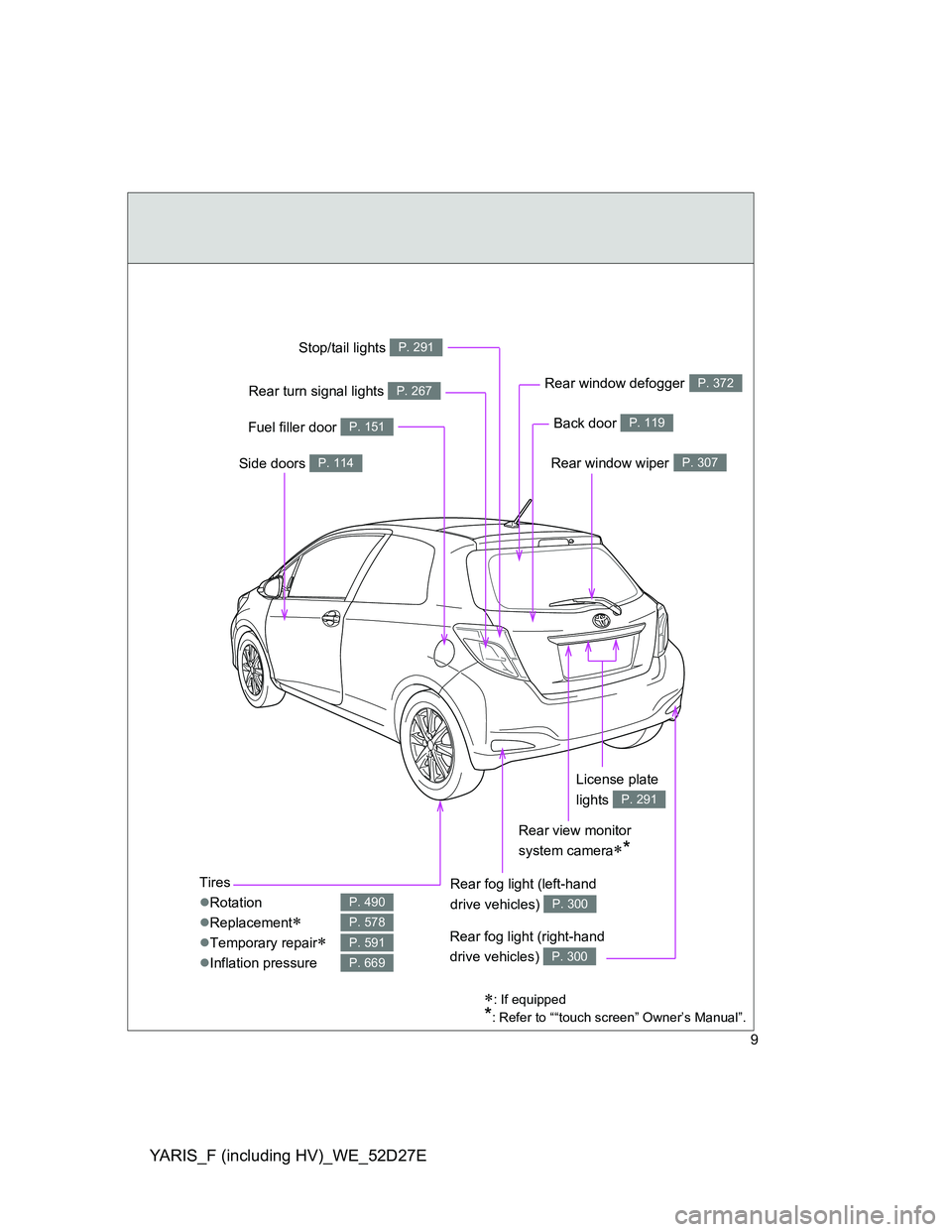
YARIS_F (including HV)_WE_52D27E
9
: If equipped
*: Refer to ““touch screen” Owner’s Manual”.
Tires
Rotation
Replacement
Temporary repair
Inflation pressure
P. 490
P. 578
P. 591
P. 669
Back door P. 119
Side doors P. 114
Fuel filler door P. 151
Rear turn signal lights P. 267Rear window defoggerP. 372
License plate
lights
P. 291
Stop/tail lights P. 291
Rear window wiperP. 307
Rear fog light (left-hand
drive vehicles)
P. 300
Rear fog light (right-hand
drive vehicles)
P. 300
Rear view monitor
system camera
*
Page 11 of 700
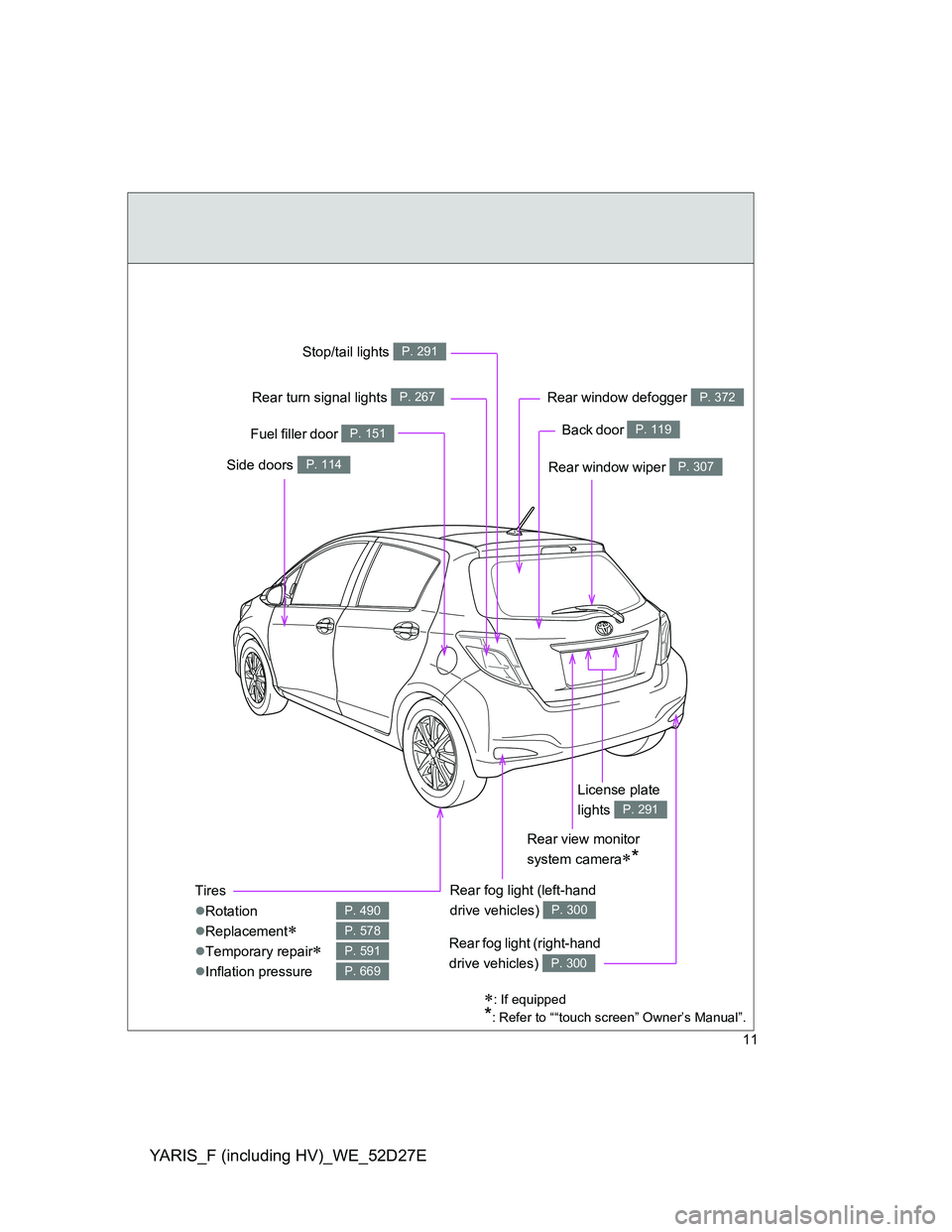
YARIS_F (including HV)_WE_52D27E
11
Rear window wiper P. 307
Tires
Rotation
Replacement
Temporary repair
Inflation pressure
P. 490
P. 578
P. 591
P. 669
Back door P. 119
Side doors P. 114
Rear window defogger P. 372
License plate
lights
P. 291
Rear fog light (right-hand
drive vehicles)
P. 300
Fuel filler door P. 151
Stop/tail lights P. 291
Rear turn signal lights P. 267
Rear fog light (left-hand
drive vehicles)
P. 300
Rear view monitor
system camera
*
: If equipped
*: Refer to ““touch screen” Owner’s Manual”.
Page 13 of 700
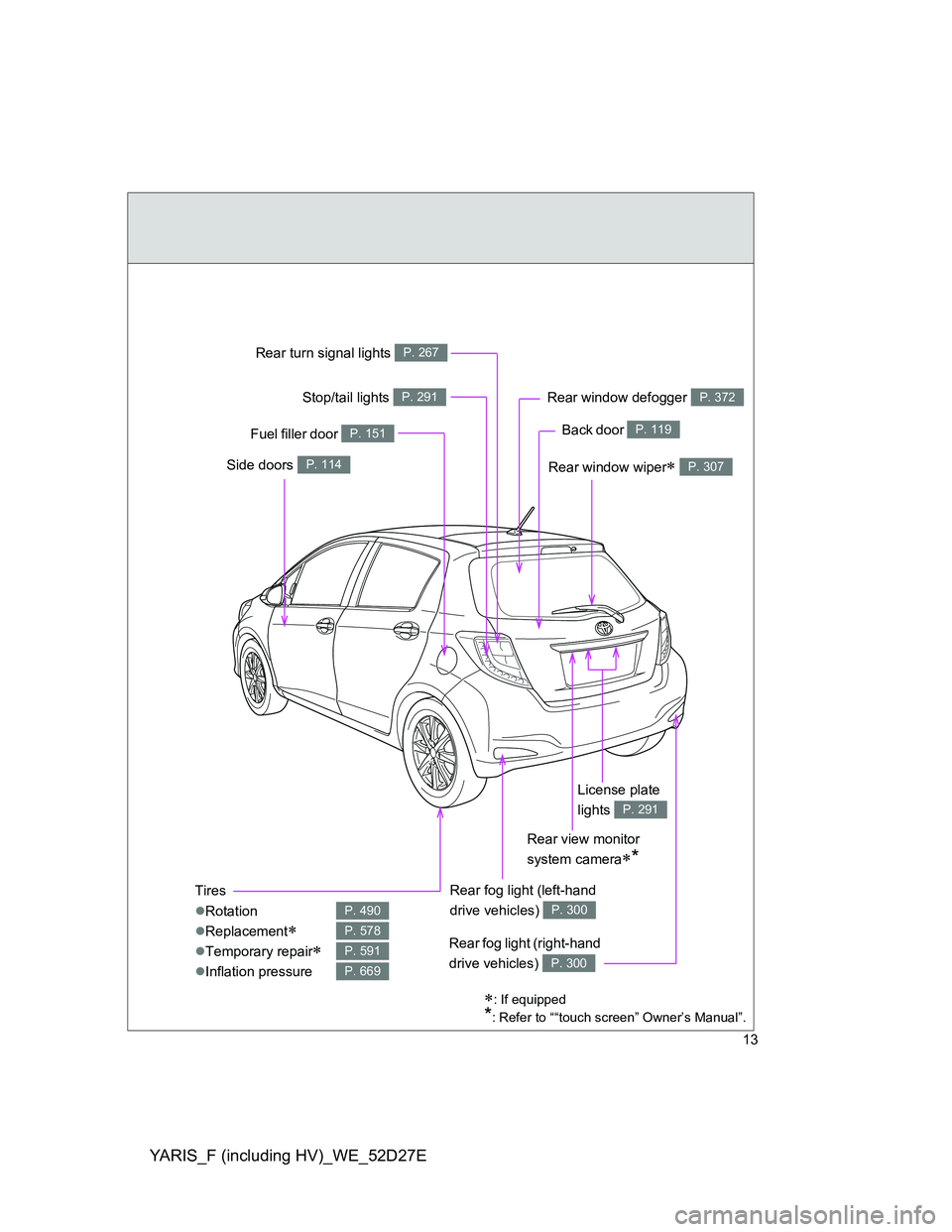
YARIS_F (including HV)_WE_52D27E
13
Rear window wiper P. 307
Tires
Rotation
Replacement
Temporary repair
Inflation pressure
P. 490
P. 578
P. 591
P. 669
Back door P. 119
Side doors P. 114
Rear window defogger P. 372
License plate
lights
P. 291
Rear fog light (right-hand
drive vehicles)
P. 300
Fuel filler door P. 151
Stop/tail lights P. 291
Rear turn signal lights P. 267
Rear fog light (left-hand
drive vehicles)
P. 300
Rear view monitor
system camera
*
: If equipped
*: Refer to ““touch screen” Owner’s Manual”.
Page 63 of 700
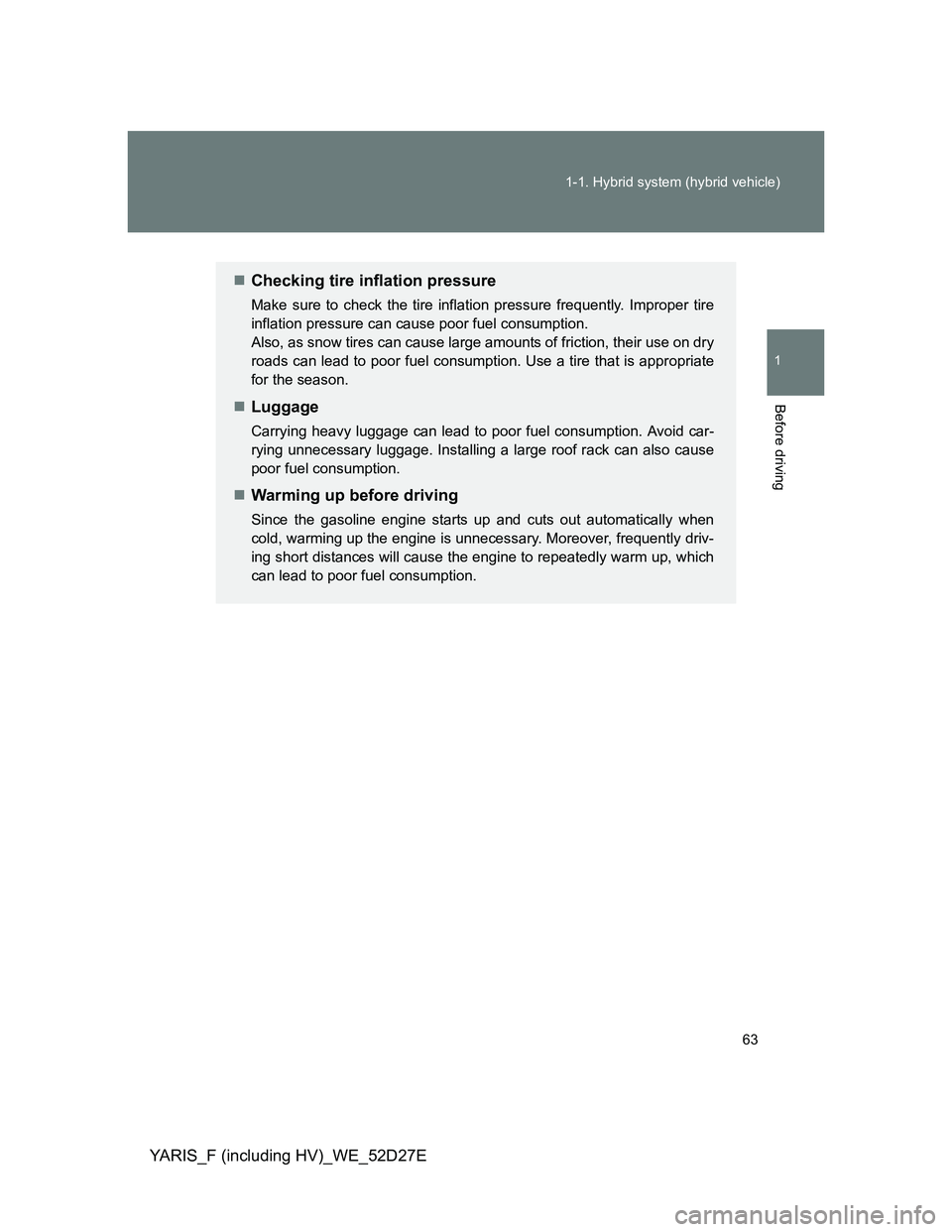
63 1-1. Hybrid system (hybrid vehicle)
1
Before driving
YARIS_F (including HV)_WE_52D27E
Checking tire inflation pressure
Make sure to check the tire inflation pressure frequently. Improper tire
inflation pressure can cause poor fuel consumption.
Also, as snow tires can cause large amounts of friction, their use on dry
roads can lead to poor fuel consumption. Use a tire that is appropriate
for the season.
Luggage
Carrying heavy luggage can lead to poor fuel consumption. Avoid car-
rying unnecessary luggage. Installing a large roof rack can also cause
poor fuel consumption.
Warming up before driving
Since the gasoline engine starts up and cuts out automatically when
cold, warming up the engine is unnecessary. Moreover, frequently driv-
ing short distances will cause the engine to repeatedly warm up, which
can lead to poor fuel consumption.
Page 329 of 700
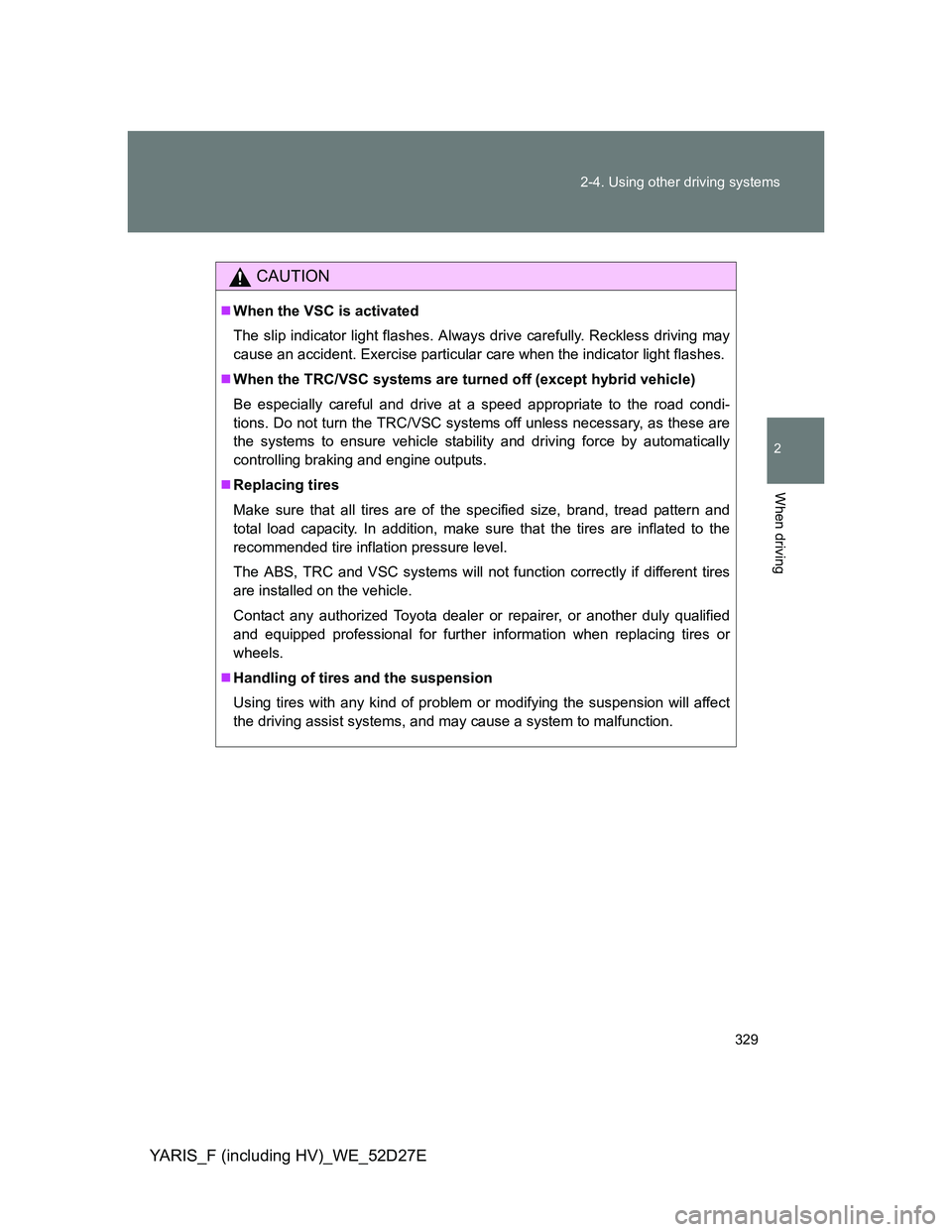
329 2-4. Using other driving systems
2
When driving
YARIS_F (including HV)_WE_52D27E
CAUTION
When the VSC is activated
The slip indicator light flashes. Always drive carefully. Reckless driving may
cause an accident. Exercise particular care when the indicator light flashes.
When the TRC/VSC systems are turned off (except hybrid vehicle)
Be especially careful and drive at a speed appropriate to the road condi-
tions. Do not turn the TRC/VSC systems off unless necessary, as these are
the systems to ensure vehicle stability and driving force by automatically
controlling braking and engine outputs.
Replacing tires
Make sure that all tires are of the specified size, brand, tread pattern and
total load capacity. In addition, make sure that the tires are inflated to the
recommended tire inflation pressure level.
The ABS, TRC and VSC systems will not function correctly if different tires
are installed on the vehicle.
Contact any authorized Toyota dealer or repairer, or another duly qualified
and equipped professional for further information when replacing tires or
wheels.
Handling of tires and the suspension
Using tires with any kind of problem or modifying the suspension will affect
the driving assist systems, and may cause a system to malfunction.
Page 443 of 700
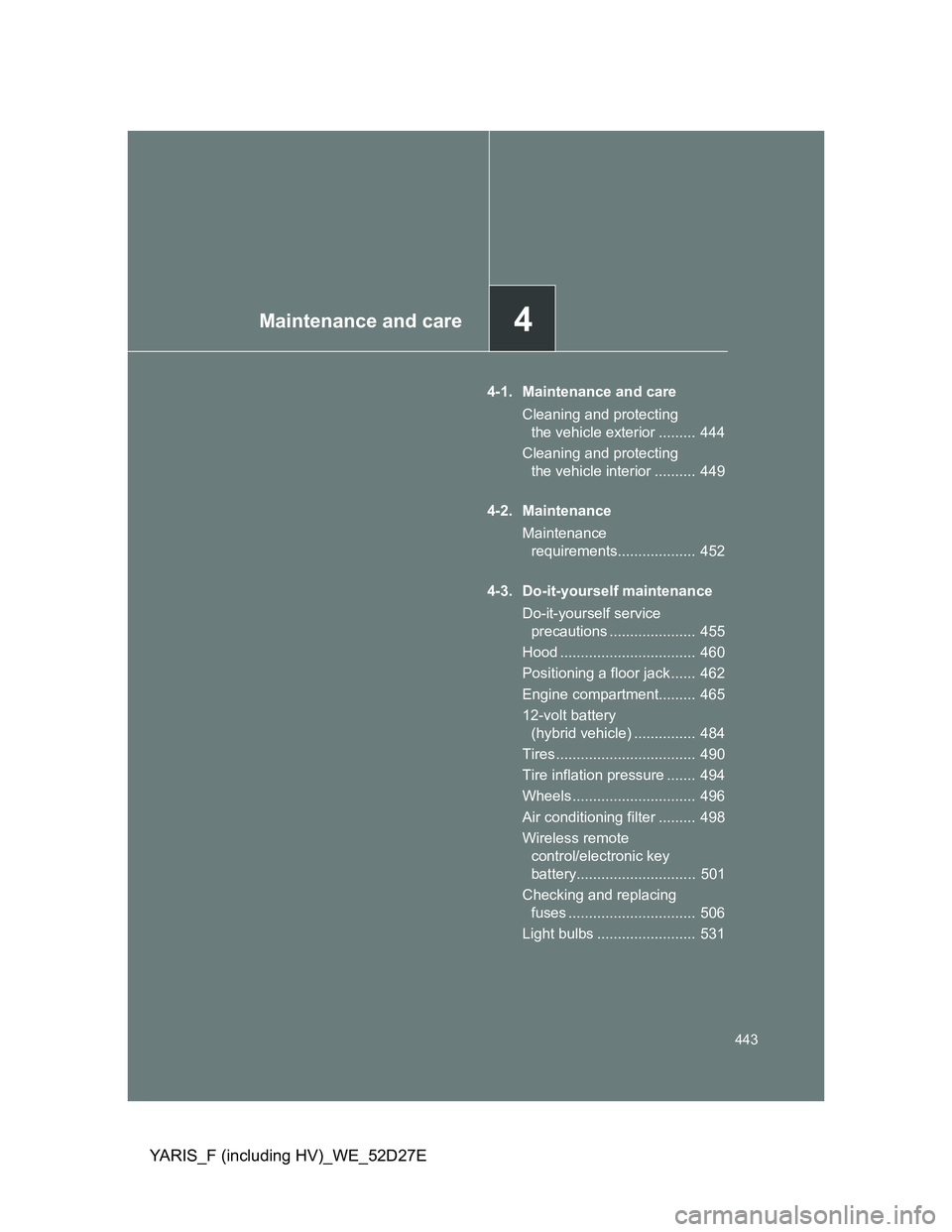
4Maintenance and care
443
YARIS_F (including HV)_WE_52D27E
4-1. Maintenance and care
Cleaning and protecting
the vehicle exterior ......... 444
Cleaning and protecting
the vehicle interior .......... 449
4-2. Maintenance
Maintenance
requirements................... 452
4-3. Do-it-yourself maintenance
Do-it-yourself service
precautions ..................... 455
Hood ................................. 460
Positioning a floor jack ...... 462
Engine compartment......... 465
12-volt battery
(hybrid vehicle) ............... 484
Tires .................................. 490
Tire inflation pressure ....... 494
Wheels .............................. 496
Air conditioning filter ......... 498
Wireless remote
control/electronic key
battery............................. 501
Checking and replacing
fuses ............................... 506
Light bulbs ........................ 531
Page 456 of 700
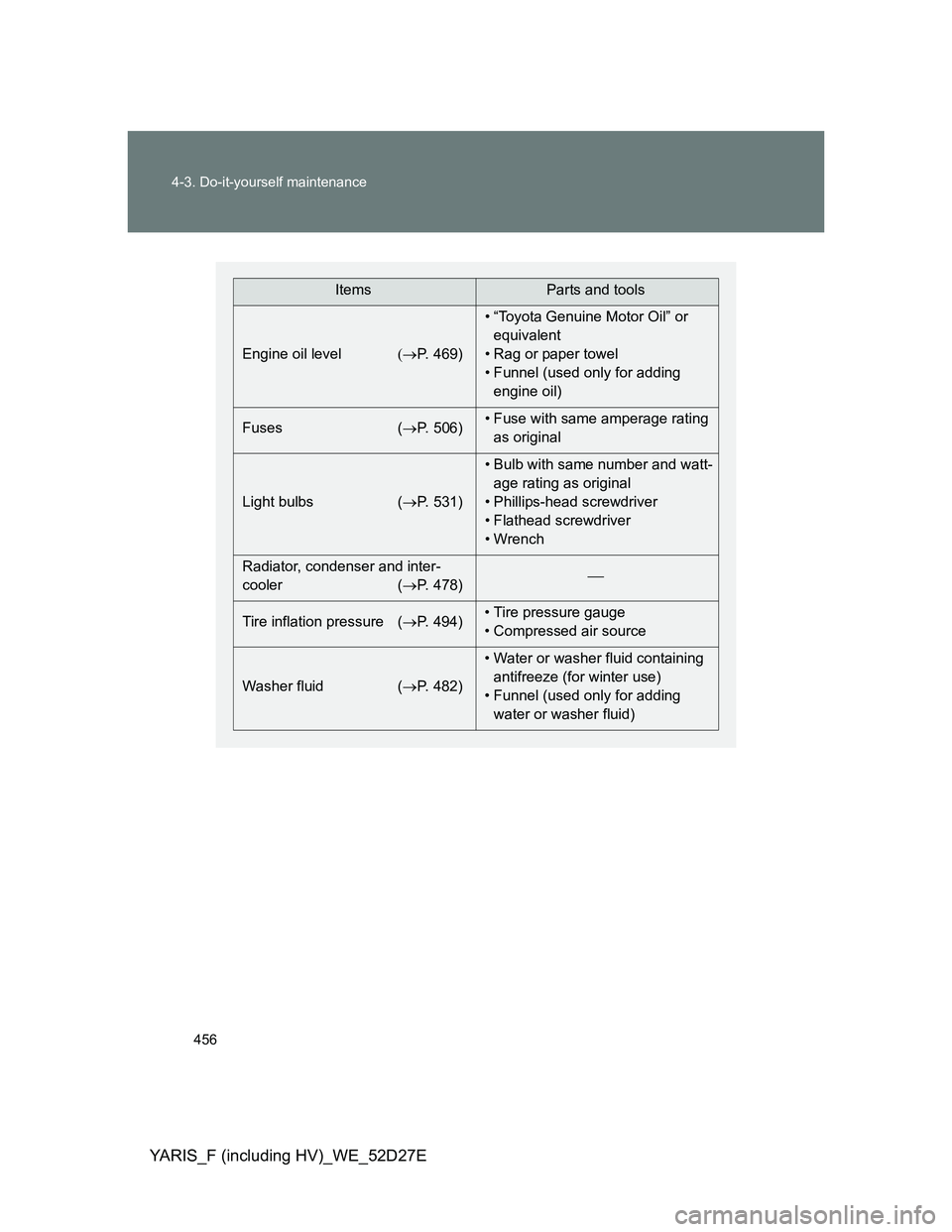
456 4-3. Do-it-yourself maintenance
YARIS_F (including HV)_WE_52D27E
ItemsParts and tools
Engine oil levelP. 469)• “Toyota Genuine Motor Oil” or
equivalent
• Rag or paper towel
• Funnel (used only for adding
engine oil)
Fuses (P. 506)• Fuse with same amperage rating
as original
Light bulbs (P. 531)• Bulb with same number and watt-
age rating as original
• Phillips-head screwdriver
• Flathead screwdriver
• Wrench
Radiator, condenser and inter-
cooler (P. 478)
Tire inflation pressure (P. 494)• Tire pressure gauge
• Compressed air source
Washer fluid (P. 482)• Water or washer fluid containing
antifreeze (for winter use)
• Funnel (used only for adding
water or washer fluid)
Page 493 of 700
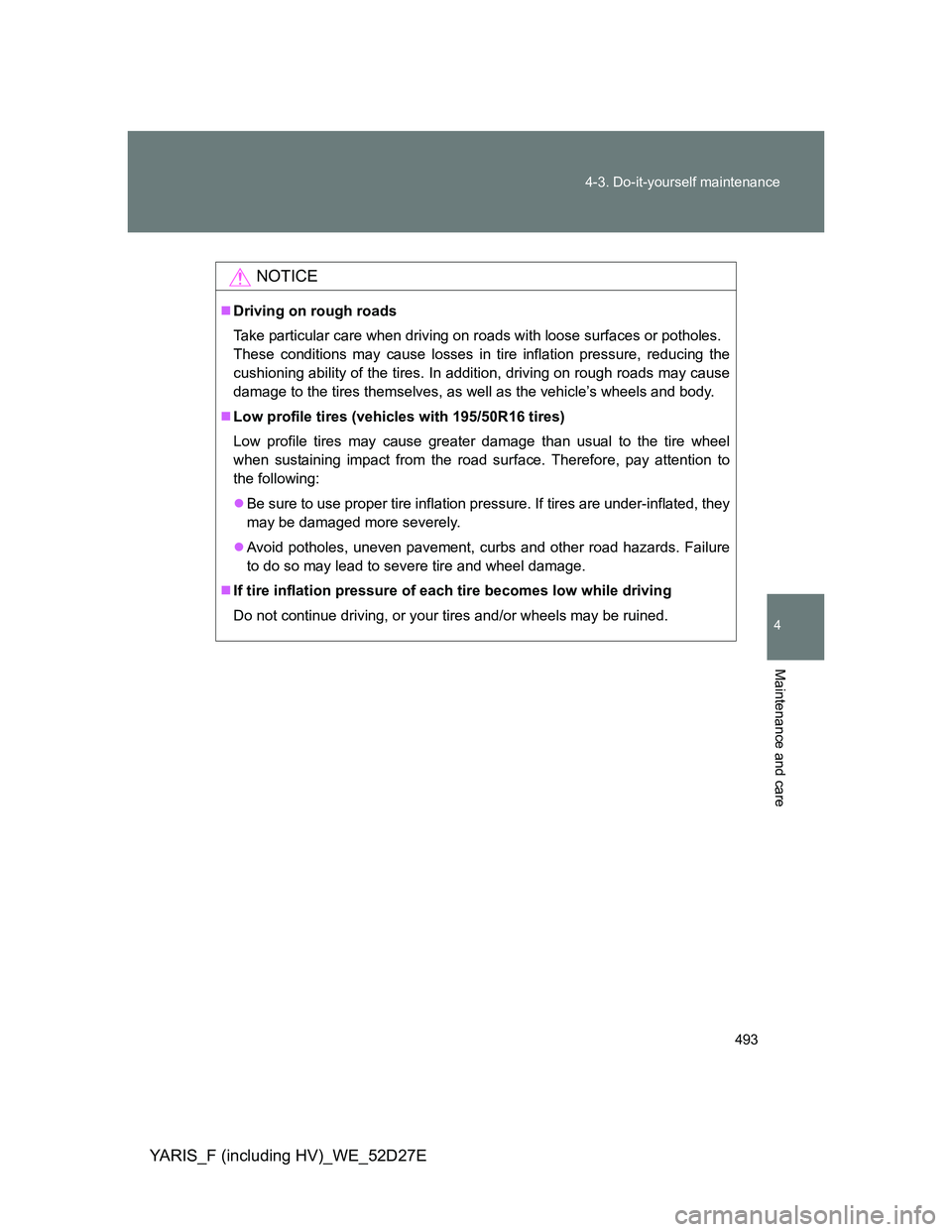
493 4-3. Do-it-yourself maintenance
4
Maintenance and care
YARIS_F (including HV)_WE_52D27E
NOTICE
Driving on rough roads
Take particular care when driving on roads with loose surfaces or potholes.
These conditions may cause losses in tire inflation pressure, reducing the
cushioning ability of the tires. In addition, driving on rough roads may cause
damage to the tires themselves, as well as the vehicle’s wheels and body.
Low profile tires (vehicles with 195/50R16 tires)
Low profile tires may cause greater damage than usual to the tire wheel
when sustaining impact from the road surface. Therefore, pay attention to
the following:
Be sure to use proper tire inflation pressure. If tires are under-inflated, they
may be damaged more severely.
Avoid potholes, uneven pavement, curbs and other road hazards. Failure
to do so may lead to severe tire and wheel damage.
If tire inflation pressure of each tire becomes low while driving
Do not continue driving, or your tires and/or wheels may be ruined.
Page 494 of 700
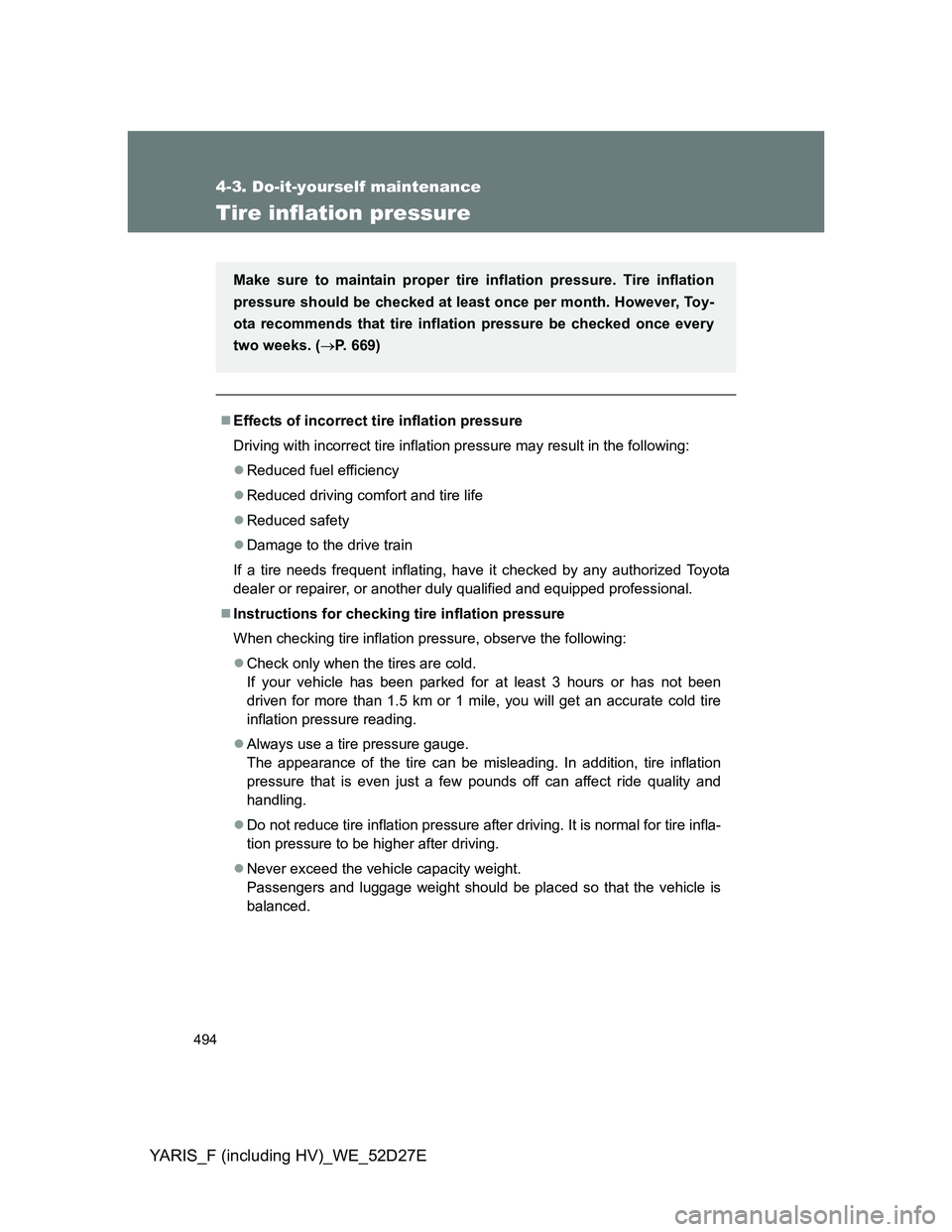
494
4-3. Do-it-yourself maintenance
YARIS_F (including HV)_WE_52D27E
Tire inflation pressure
Effects of incorrect tire inflation pressure
Driving with incorrect tire inflation pressure may result in the following:
Reduced fuel efficiency
Reduced driving comfort and tire life
Reduced safety
Damage to the drive train
If a tire needs frequent inflating, have it checked by any authorized Toyota
dealer or repairer, or another duly qualified and equipped professional.
Instructions for checking tire inflation pressure
When checking tire inflation pressure, observe the following:
Check only when the tires are cold.
If your vehicle has been parked for at least 3 hours or has not been
driven for more than 1.5 km or 1 mile, you will get an accurate cold tire
inflation pressure reading.
Always use a tire pressure gauge.
The appearance of the tire can be misleading. In addition, tire inflation
pressure that is even just a few pounds off can affect ride quality and
handling.
Do not reduce tire inflation pressure after driving. It is normal for tire infla-
tion pressure to be higher after driving.
Never exceed the vehicle capacity weight.
Passengers and luggage weight should be placed so that the vehicle is
balanced.
Make sure to maintain proper tire inflation pressure. Tire inflation
pressure should be checked at least once per month. However, Toy-
ota recommends that tire inflation pressure be checked once every
two weeks. (P. 669)